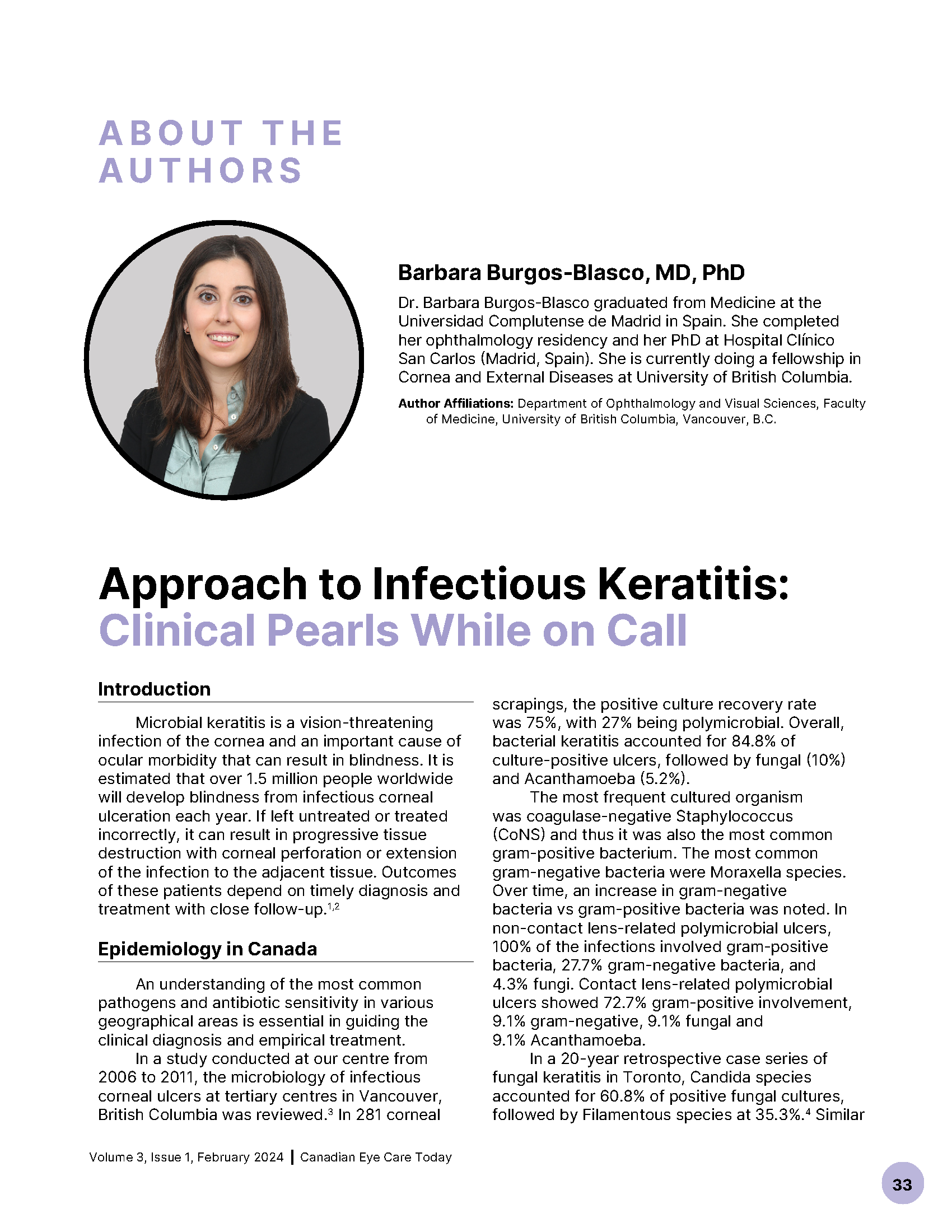Approach to Infectious Keratitis: Clinical Pearls While on Call
Abstract
Microbial keratitis is a vision-threatening infection of the cornea and an important cause of ocular morbidity that can result in blindness. It is estimated that over 1.5 million people worldwide will develop blindness from infectious corneal ulceration each year. If left untreated or treated incorrectly, it can result in progressive tissue destruction with corneal perforation or extension of the infection to the adjacent tissue. Outcomes of these patients depend on timely diagnosis and treatment with close follow-up.
References
Whitcher JP, Srinivasan M, Upadhyay MP. Corneal blindness: a global perspective. Bull World Health Organ. 2001;79:214–21.
Brown L, Leck AK, Gichangi M et al. The global incidence and diagnosis of fungal keratitis. Lancet Infect Dis 2021;21:e49–57.
Termote K, Joe AW, Butler AL et al. Epidemiology of bacterial corneal ulcers at tertiary centres in Vancouver, B.C. Can J Ophthalmol. 2018;53:330–6.
Trinh T, Emami S, Gould J et al. Clinical and microbiological analysis of fungal keratitis in Toronto, Canada: A 20-year study. Med Mycol. 2022;60.
Qiao GL, Ling J, Wong T et al. Candida keratitis: epidemiology, management, and clinical outcomes. ARVO Annual Meeting, Vancouver, Canada: n.d.
Noureddin GS, Sasaki S, Butler AL et al. Paediatric infectious keratitis at tertiary referral centres in Vancouver, Canada. Br J Ophthalmol. 2016;100:1714‑8.
Ling JY, Yeung SN, Chan C, et al. Trends and clinical outcomes of fungal keratitis in Canada: a 20-year retrospective multicentre study. Ocul. Microbiol. Immunol Abstract. 2023. General Meeting, Pittsburg, PA.
Allan BD, Dart JK. Strategies for the management of microbial keratitis. Br J Ophthalmol. 1995;79:777–86.
American Academy of Ophthalmology: Basic Clinical and Science Course, Section 8, External Disease and Cornea.
Lin A, Rhee MK, Akpek EK et al. Bacterial keratitis preferred practice pattern®. Ophthalmology. 2019;126:P1–55.
Pakzad-Vaezi K, Levasseur SD, Schendel S et al. The corneal ulcer one-touch study: a simplified microbiological specimen collection method. Am J Ophthalmol. 2015;159:37-43.e1.
Blondeau JM, Sanfilippo CM, Morris TW et al. In vitro antibiotic susceptibility profile of ocular pathogens—results from the first ARMOR Canada Surveillance Study. Assoc. Res. Vis. Ophthalmol. Annual Meeting. Orlando, FL: n.d., p. Poster 2840-B0073.
Loviano A. Unpublished data.
Hoffman JJ, Yadav R, Sanyam SD et al. Topical chlorhexidine 0.2% versus topical natamycin 5% for the treatment of fungal keratitis in Nepal: a randomized controlled noninferiority trial. Ophthalmology. 2022;129:530–41.
Hariprasad SM, Mieler WF, Holz ER et al. Determination of vitreous, aqueous, and plasma concentration of orally administered voriconazole in humans. Arch Ophthalmol. 2004;122:42–7.
Herretes S, Wang X, Reyes JMG. Topical corticosteroids as adjunctive therapy for bacterial keratitis. Cochrane Database Syst Rev. 2014 Oct 16;10(10): CD005430.
Srinivasan M, Mascarenhas J, Rajaraman R et al. Corticosteroids for bacterial keratitis: the steroids for corneal ulcers Trial (SCUT). Arch Ophthalmol. 2012;130:143–50.
Gokhale NS. Medical management approach to infectious keratitis. Indian J Ophthalmol. 2008;56:215‑20.
Austin A, Lietman T, Rose-Nussbaumer J. Update on the management of infectious keratitis. Ophthalmology. 2017;124:1678–89.

Downloads
Published
How to Cite
Issue
Section
License
Copyright (c) 2024 Canadian Eye Care Today

This work is licensed under a Creative Commons Attribution-NonCommercial-NoDerivatives 4.0 International License.
